Articles

LucasArts.com 20th Anniversary History Feature Part Two: The Classics, 1990 - 1994
This is the second of a four part history of LucasArts. The information in this story is based on company documents, historical publications from other developers and publishers, and past and present employee recollections.
By the early 1990s, Lucasfilm Games had firmly established itself as a leading developer and publisher of interactive entertainment. To underscore its unique identity, the division was re-named LucasArts Entertainment Company and its offices were moved from Skywalker Ranch to a nearby office building. At the same time, a new logo was commissioned. Affectionately known as “the gold guy” logo, it debuted in the early 90s and is still used to this day.
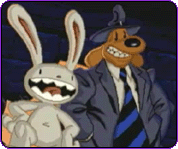
During the early 1990s, some of the best adventure games of all time would be produced by LucasArts including Sam & Max Hit the Road®, Day of the Tentacle® and the Monkey Island® series. The company also began working on games that would bring the Star Wars® universe to life as an interactive experience.
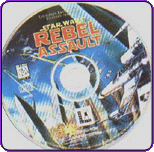
LucasArts also began to experiment with new technologies, including game consoles such as the Super Nintendo and Sega Genesis. iMUSE, an interactive music system that allowed game designers to dynamically change in-game music according to the player's actions, was an innovation developed by LucasArts for the adventure games of this period. The CD-ROM, however, was the one piece of technology that would forever change the way LucasArts went about producing its games. During this era, the “talkie” CD-ROM game was born, which allowed adventure game characters to actually speak their words for the first time. LucasArts also aggressively explored adding full motion video to its games. 1993's Rebel Assault® was a watershed product that featured full motion video clips from the Star Wars films.
Classic Adventures
- Loom® (January 1990, IBM, Amiga, Atari ST, Macintosh, PC CD-ROM, FM Towns, Super CD)
- The Secret of Monkey Island® (October 1990, IBM, Amiga, Atari ST, Macintosh, PC CD-ROM, CDTV, Sega CD)
- Monkey Island 2: LeChuck's Revenge® (December 1991, IBM, Amiga, Color Macintosh)
- Indiana Jones® and the Fate of Atlantis™ (June 1992, IBM, Amiga, Color Macintosh, PC CD-ROM)
- Maniac Mansion® II: Day of the Tentacle (June 1993, IBM, PC CD-ROM, Mac CD-ROM)
- Sam & Max Hit the Road (November 1993, IBM, PC CD-ROM, Mac CD-ROM)
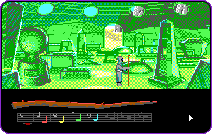
While some might assume that all of LucasArts' adventure games in the early 1990s were humorous, that's not actually the case. Loom, released in 1990, was a serious and thought-provoking fantasy adventure. Players assumed the role of Bobbin Threadbare, a 17-year-old boy in the Guild of Weavers. But instead of weaving thread, Bobbin used a staff to weave magical music that helped him challenge a darkness that had overcome the land. The player casts magic spells by using notes on the standard musical C major scale. On lower difficulty settings, it was not necessary to know how to read or write music to successfully complete the game. Many players fondly remember the beautiful classical music in the game, not to mention Bobbin's epic journey to destroy darkness.
Another young man would begin his own epic journey in October 1990. Guybrush Threepwood was a pirate-wannabe who starred in his own comedy adventure, The Secret of Monkey Island.

Set on Melee Island in the Caribbean, Guybrush battled against the evil ghost pirate LeChuck who had captured the beautiful governor of the island, Elaine Marley. During the game, Guybrush had to complete three trials to become a pirate: thievery, verbal insult sword fighting, and treasure hunting. Most of the fun in the game came from the branching dialog trees, where players had the chance to select how they conversed with in-game characters.
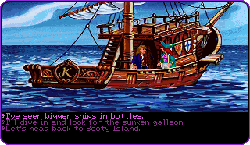
Guybrush's witty repartee with these characters continued in the sequel, Monkey Island 2: LeChuck's Revenge. It shipped just over one year after the original game, and was the first cover to feature “the gold guy” logo. This second game told the tale of Guybrush's search for the treasure all pirates dream of: Big Whoop on Scabb Island. Unfortunately, Guybrush found out Largo LaGrande had stolen LeChuck's beard and revived him into a rotten zombie. Monkey Island 2 was another classic adventure, perhaps best remembered for its shocking ending set at an amusement park on Dinky Island.
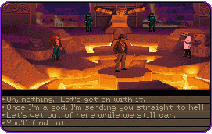
While Lucasfilm Games had published an Indiana Jones game in 1989 to coincide with the film Indiana Jones and the Last Crusade, 1993 brought the release of the first original Indiana Jones game. The plot for Indiana Jones and the Fate of Atlantis was completely new. It told the tale of how Indiana and his cohort Sophia raced to find Atlantis before the Third Reich could use the Lost City's power for evil. Besides including LucasArts' trademark witty dialogue and interesting puzzles, Fate of Atlantis featured multiple ways to complete the game. Part way through the adventure, players selected between three paths: the more action-oriented FISTS path; the intellectually stimulating WITS path; or the TEAM path where Sophia would offer Indy hints during their adventure. The game also came out as a “talkie” CD-ROM with more than 8,000 lines of dialogue.
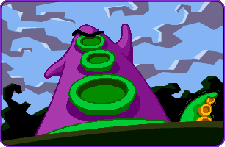
In 1993, the designers at LucasArts decided to bring back one of their classics from the 1980s. Day of the Tentacle was a sequel to Maniac Mansion, although it featured a completely new plot and many new characters. The game shipped simultaneously as a “talkie” CD-ROM and on floppy disk. In this humorous adventure, players took control of three characters: Bernard, a loveable computer geek; Laverne, a sleep deprived medical student; and Hoagie, a brain-dead rock roadie (view all three character sketches in the 20th Anniversary Art Gallery). These characters were brought together to prevent Dr. Fred's Purple Tentacle from taking over the world. Using a Chron-O-John time machine, made out of three port-o-potties and a VW Bug, characters passed objects back and forth through time.
“Caution: Naked Bunny with Attitude” was the sticker on the box to Sam & Max Hit the Road, the final classic LucasArts adventure from the early 1990s. In this game, players controlled two freelance police detectives: Sam, a canine, and Max, his hyperactive rabbit partner. This odd couple traveled throughout America on the trail of a runaway carnival bigfoot named Bruno. Locations in the game included The World's Largest Ball of Twine and The Mount Rushmore Dinosaur Tarpit. There also were action sequences such as the famous Wak-A-Rat™ game.
All of these classic adventure games followed a unique game design rule: Never let the player die. As a result, players didn't have to worry about constantly saving their game. This design principle became a trademark of LucasArts' classic adventures.
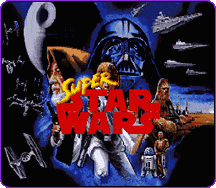
Star Wars - JVC
- Star Wars (November 1991, NES)
- The Empire Strikes Back™ (December 1991, NES)
- Super Star Wars (November 1992, SNES)
- Super Empire Strikes Back™ (November 1993, SNES)
- Super Return of the Jedi™ (November 1994, SNES, DOS, Gameboy)
While PC gamers enjoyed many classic adventure games during the early 90s, console gamers also had a chance to experience LucasArts' products. In 1991, LucasArts partnered with JVC Musical Industries, Inc. to launch the first Star Wars titles for game consoles. Based on the classic movie trilogy, these side-scrolling games let players assume the roles of characters such as Luke Skywalker, Han Solo, Princess Leia, Chewbacca, and even Wicket the Ewok. In addition to the side-scrolling action, some of the games included flight sequences. For example, Volksjaeger let players fly the X-wing during the Death Star trench run. The games were well received by critics and fans: Super Star Wars was awarded a perfect score from GamePro Magazine, and Nintendo Power magazine called it one of the five best Super Nintendo titles of 1992.
World War II Flight Simulations
- Secret Weapons of the Luftwaffe® (August 1991, IBM, PC CD-ROM)
- Tours of Duty: P-38 Lightning (1991); P-80 Shooting Star (1992); He162 Volksjaeger (1992); Do335 Pfeil (1992) (February 1993, IBM, PC CD-ROM, Mac CD-ROM)
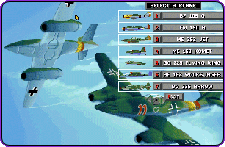
After the success of the simulation titles Their Finest Hour: The Battle of Britain® and Battlehawks 1942® in the late 80s, LucasArts decided to follow up those games with another World War II simulation title: Secret Weapons of the Luftwaffe. Released in August 1991, the game followed the campaign by the US 8th Air Force to cripple the German Luftwaffe during the final years of World War II. Players could fly in either American or German warplanes. The game was remarkable because many of the playable airplanes were still under development during the war. In other words, the planes were never used extensively in battle, so players could explore “what if ” possibilities with the game. Those possibilities were further expanded by four Tour of Duty expansion packs. The planes in those expansions included the P-38 Lighting, a twin-engine escort fighter and the German Do335, an interceptor aircraft that featured a conventional tractor propeller in the nose as well as a pusher propeller behind the tail of the aircraft.
Star Wars - LucasArts
- Star Wars X-Wing® (February 1993, IBM, PC CD-ROM, Mac CD-ROM)
- Star Wars: TIE Fighter® (July 1994, IBM, Mac CD-ROM)
- Star Wars: Rebel Assault (November 1993, PC CD-ROM, Sega CD, Mac CD, 3DO)
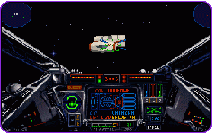
After spending years working on airborne simulators in the World War II era, it was only natural that the simulation team inside LucasArts would next turn to Star Wars space flight. Star Wars: X-Wing was a milestone game, and carries the distinction of being the first Star Wars title published by LucasArts. It was also one of the first simulation games to include 3D polygon graphics for spaceships, as opposed to less-detailed bitmap graphics that were typically used in flight games. In X-Wing, players suited up as a new Rebel Alliance pilot. Although the game was named X-Wing, it was possible to fly the Y-wing and A-wing as well. Missions included escorting transports, dog fighting against Imperial TIE Fighters and attacking the Death Star. X-Wing was a huge success. It went on to become one of the top selling PC games of 1993.
The tables were quickly turned, and Star Wars: TIE Fighter came out a year after X-Wing. Now players were allowed to fight for the Empire, under the charge of Darth Vader and other Imperial commanders. With extensive non-linear combat missions and a compelling story fraught with political intrigue, TIE Fighter was a faithful sequel to X-Wing. It also firmly cemented LucasArts' standing as a leading publisher of flight combat simulations.
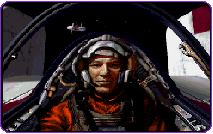
Star Wars: Rebel Assault also included space flight combat, but it was a game much more focused on arcade-like gameplay as opposed to the more detailed simulation models for X-Wing and TIE Fighter. What made Rebel Assault so remarkable was its inclusion of full motion video clips from the Star Wars movies. Designed as LucasArts' first product to come out only on CD-ROM, the game began with a digitized version of John Williams' overture from the films. Rebel Assault was set up in a series of game chapters, with each chapter providing a different type of gameplay. The game began with the player flying a starship through Beggar's Canyon. Other levels featured flying starships in outer space and attempts to infiltrate an Imperial base on foot. Rebel Assault became one of the best-selling CD-ROM titles of its time, with more than one million copies sold.
Others
- Night Shift® (October 1990, IBM, Amiga, Atari ST, Macintosh)
- Defenders of Dynatron City® (August 1992, NES)
- Zombies Ate My Neighbors® (September 1993, SNES, Genesis)
- Ghoul Patrol® (November 1994, SNES)
LucasArts also released several other zany titles during this time period. In Night Shift, players struggled to meet quotas as a toy factory employee who produced action figures from Star Wars and Indiana Jones. The game box included the tagline “Industrial Might & Logic,” a play on words of the name of George Lucas' visual effects company, Industrial Light & Magic.
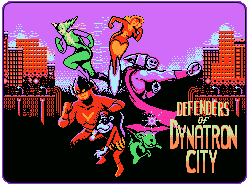
Three other console games also arrived in the early 1990s. Defenders of Dynatron City featured six wacky superheroes fighting crime in a city where mutation was a way of life. Zombies Ate My Neighbors was an action/horror title where two characters, Zeke and Julia, had to fight vampires, mummies and zombies with weapons such as a squirt gun and a blob-destroying ice pop. Finally, Ghoul Patrol, the sequel to Zombies Ate My Neighbors, had Julie and Zeke battle against demons.
By the end of this particular period, LucasArts had established itself as a top-10 PC game publisher, with two of its games at the top of the charts in 1993: X-Wing and Rebel Assault. Moving into the next phase of its history, LucasArts planned to continue exploring the adventure and simulation genres. But it also hoped to broaden its horizons and explore a number of other types of games and new gaming platforms.